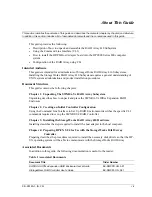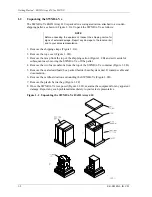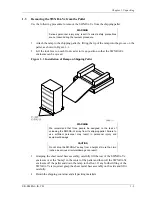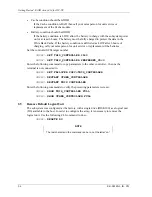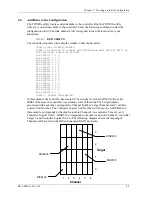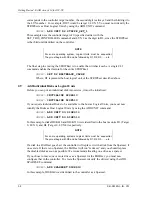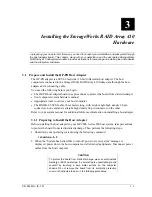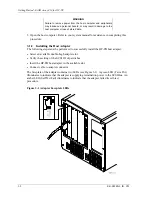
Chapter 2. Creating an Initial Configuration
EK–SMRA3–IG. C01
2–7
NOTE
For some operating systems, Logical Units must be sequential.
They must begin with D0 and be followed by D1, D2, D3, ..... etc.
The final step in creating the RAIDset is to enable the writeback cache. A single CLI
command enables that feature for the entire RAIDset:
SWXRC> SET D0 WRITEBACK_CACHE
SWXRC> SET D1 WRITEBACK_CACHE
Where: D0 and D1 represent the host logical units of the RAIDsets described above.
2.8
Create a STRIPEset
If you require STRIPE sets to be available to the host as Logical Units, you must now
combine disks into a STRIPEset. STRIPEsets must have at least two members, and can have
as many as fourteen. This example creates a three member STRIPEset using the ADD
STRIPESET command.
SWXRC> ADD STRIPESET STRIPE_SET_1 DISK110 DISK210 DISK310
In this example, “STRIPE_SET_1” is the name of the STRIPEset, and it is followed by a list
of the disks to be included in the STRIPEset. The names of the STRIPEsets are user
selectable. Performance of your STRIPEsets will be optimized if each STRIPEset includes
disks from different channels as shown in the example on page 2-5.
2.8.1 Initialize the STRIPEset
Before you can put the STRIPEset into service, it must be initialized.
When you initialize a STRIPEset, a chunksize must be specified. A chunksize is the number
of blocks of data that are transferred at one time. By using the default chunksize, the
controller will optimize the chunksize by selecting a number equal to the number of blocks in
one track of disk data. We recommend using the default chunksize.
SWXRC> INITIALIZE STRIPE_SET_1 CHUNKSIZE=DEFAULT
NOTE
Valid chunksizes are 16 – 32768 blocks. You should use a larger
chunksize for applications that make a lot of I/O requests. Use a
smaller chunksize for applications that make relatively few I/O
requests, but need to move large amounts of data with each
request.
2.8.2 Add the STRIPEset as a Logical Unit
To make a STRIPEset available to the host computer, you must identify it as a host logical
unit. The unit number is a one or three digit number preceded by “D”. The unit number
identifies the controller’s target number and the STRIPEset as the Logical Unit (LUN)
connected to the target. Units identified with controller target number 0 have a single digit
number which corresponds to LUN number. For example, D5 would be target 0, LUN 5.
Units identified with controller targets 1, 2 and 3 use a 3 digit number. The first digit
Summary of Contents for RAID Array 410
Page 25: ...Getting Started RAID Array 410 for HP UX 2 12 EK SMRA3 IG C01 Date__________________ LUN Uses...
Page 41: ...Getting Started RAID Array for HP UX A 2 EK SMRA3 IG C01 Date_____________ LUN Uses...
Page 43: ...Getting Started RAID Array for HP UX A 4 EK SMRA3 IG C01 Date_____________ LUN Uses...
Page 45: ...Getting Started RAID Array for HP UX A 6 EK SMRA3 IG C01 Date_____________ LUN Uses...
Page 47: ...Getting Started RAID Array for HP UX A 8 EK SMRA3 IG C01 Date_____________ LUN Uses...

